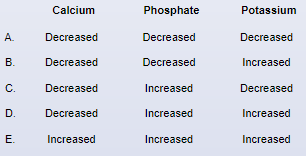A 16-year-old boy is brought to the emergency department due to a week of fever, dry cough, and weakness. Examination shows diffuse lymph node enlargement, mild hepatosplenomegaly, and scattered petechiae on the extremities. The testicles are normal and no neurologic abnormalities are present. Laboratory results are as follows:  Peripheral blood smear reveals extensive blasts, and subsequent flow cytometry reveals T cell markers. A diagnosis of acute lymphoblastic leukemia is made. The patient is initiated on intravenous fluids, allopurinol, and combination chemotherapy. The following day, he develops nausea. Cardiac monitoring shows frequent premature ventricular beats. Repeat laboratory evaluation reveals leukocytes are 52,000/mm3, blood urea nitrogen is 34 mg/dL, serum creatinine is 2.1 mg/dL, and lactate dehydrogenase level is 12,000 U/L. Which of the following additional results are expected in this patient?
Peripheral blood smear reveals extensive blasts, and subsequent flow cytometry reveals T cell markers. A diagnosis of acute lymphoblastic leukemia is made. The patient is initiated on intravenous fluids, allopurinol, and combination chemotherapy. The following day, he develops nausea. Cardiac monitoring shows frequent premature ventricular beats. Repeat laboratory evaluation reveals leukocytes are 52,000/mm3, blood urea nitrogen is 34 mg/dL, serum creatinine is 2.1 mg/dL, and lactate dehydrogenase level is 12,000 U/L. Which of the following additional results are expected in this patient?
Definitions:
Acute Illness
A disease or condition that comes on suddenly and is typically short in duration, often requiring immediate care.
Bacterial Meningitis
An infectious disease causing inflammation of the protective membranes covering the brain and spinal cord, often life-threatening without prompt treatment.
Type 2 Diabetes
A chronic condition that affects the way the body processes blood sugar (glucose), characterized by insulin resistance and/or reduced insulin production.
Multiple Sclerosis
A chronic, autoimmune disease that affects the central nervous system, leading to varying levels of disability.
Q25: A 42-year-old woman comes to the office
Q267: A 35-year-old woman is evaluated due to
Q641: A 46-year-old man is admitted to the
Q885: A 56-year-old hospitalized man is evaluated for
Q892: A 28-year-old woman comes to the urgent
Q1040: A 68-year-old man comes to the emergency
Q1255: A 68-year-old man comes to the emergency
Q1396: A 43-year-old, previously healthy man is hospitalized
Q1523: A 55-year-old man comes to the emergency
Q1634: A 20-year-old college student is brought to